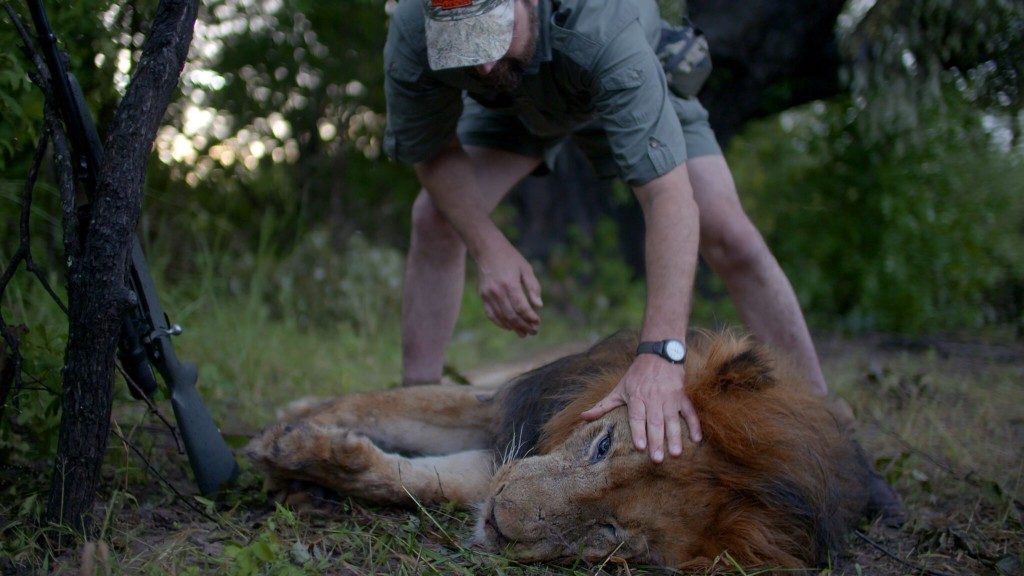Christina Clusiau is a documentary filmmaker, cinematographer, and photojournalist based in Brooklyn, NY. In 2013, Clusiau co-founded Reel Peak Films, a production company specializing in short and long-form documentary films, commercials, and television content made with cinematic quality and journalistic integrity. She shot the Emmy-nominated web series “A Year in Space” in partnership with TIME Magazine’s Red Border Films, as well as the feature documentary “Aida’s Secrets.”
“Trophy” will premiere at the 2017 Sundance Film Festival on January 20. The film is co-directed by Shaul Schwarz.
W&H: Describe the film for us in your own words.
CC: “Trophy” takes an in-depth look at the multi-billion dollar industry behind big-game hunting and breeding. We explore and question the complex consequences of imposing economic value on wild animals.
What are the ethical implications of our practices in treating animals as commodities? And does breeding and hunting offer some of the few remaining solutions to conserve and protect them?
W&H: What drew you to this story?
CC: Coming from a background in photojournalism, I like getting close to people’s lives and bringing the viewer into worlds that they may know little about. I am curious and interested in a lot of subjects, especially the ones that are polarizing as in “Trophy.”
My interest in this story developed in a unique way. In 2013, my directing partner, Shaul Schwarz, stumbled across a picture of a man posing over an elephant that he had just hunted. He flipped to the next picture where the hunter was smiling, proudly, while cutting off the elephant’s tail. The pictures outraged him.
I grew up in northern Minnesota, where hunting is a very common practice. I spent a lot of time with friends in deer stands and camps, even though I never hunted myself. When Shaul shared that image, he never understood how people could hunt a deer, or a lion, or an elephant.
It wasn’t foreign to me because the idea and practice of it had always existed in my world. That pushed us to explore the subject more, and through our journey we learned that what seemed to be right and wrong isn’t so black and white; it’s more complex than that.
W&H: What do you want people to think about when they are leaving the theater?
CC: The ability for us to grapple with the complex issues of this subject is the same journey we hope that the audience will take. We want viewers to come into the theater with their preconceived notions of how they feel about this subject and leave with questions challenging their own beliefs while learning something new in the process.
W&H: What was the biggest challenge in making the film?
CC: One of the biggest challenges was navigating the complexities of the subject and questioning my own beliefs.
Another was keeping access to the characters and the hunting industry, which is quite a closed industry, for the duration of the three-year production.
W&H: How did you get your film funded? Share some insights into how you got the film made.
CC: Our prime funder was Impact Partners, and as the project continued we received grants and additional funding.
We also had incredible support from our producers and executive producers. They really believed in the film and kept pushing to get it made.
W&H: What does it mean for you to have your film play at Sundance?
CC: It’s a great honor and a great jumping-off place for the film. The community that attends the festival is engaged, interested, and excited about films. To have a full theater the first time your finished film is on a big screen is both exciting and nerve-racking.
The film explores a complex subject that is at times tough to watch, but it’s important. I believe that people want to be part of the solution to conserve animals and delay their extinction, and this festival is a great place to start that conversation.
Also, I thank the programmers at Sundance for seeing through the complexity of this subject and wanting to program it.
W&H: What’s the best and worst advice you’ve received?
CC: The best advice: Stay hungry. Stay humble.
The worst advice: That’s a tough one, and nothing specific comes to mind, but sometimes it’s challenging to be pushed to compromise in decisions that you feel are wrong for a project.
W&H: What advice do you have for other female directors?
CC: Don’t quit. If someone shuts the door on you, climb through the window. It may sound cliché, but it takes a lot of perseverance and resilience to keep going on a project.
W&H: Name your favorite woman-directed film and why.
CC: I have a lot favorites. One that comes to mind is “Bombay Beach” by Alma Har’el. It’s beautifully cinematic, lyrical, and shows such intimacy with the characters’ lives.
I really admire stories of people’s lives that are told in unique and beautiful ways.
W&H: Have you seen opportunities for women filmmakers increase over the last year due to the increased attention paid to the issue? If someone asked you what you thought needed to be done to get women more opportunities to direct, what would be your answer?
CC: I am not sure if I have seen opportunities for women filmmakers increase or decrease specifically over the past year. I know there are a lot opportunities out there.
I think it’s important to keep highlighting the work of female directors and for organizations, collectives, and communities to continue creating space for us to be engaged with each other on projects.






